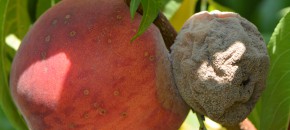This week in Fruit IPM: Click to View | Download PDF
Continue reading...Fruit IPM Report 7-28-2015
Vegetable Twilight Meeting & Research Tour
Date: Thursday, August 20, 2015, 5:30 p.m. Location: Meet at the trailer near parking lot Rutgers Agricultural Research & Extension Center 121 Northville Road, Bridgeton, NJ (Upper Deerfield) Agenda 5:30: Taste the new tomato breeding lines that will be released soon and tour the tomato plots Tom Orton, PhD, Specialist in Vegetables Check out a […]
Continue reading...Veg IPM Update: Week Ending 7/29/15

Sweet Corn European corn borer (ECB) adult activity is stable, with low level activity in parts of the state now. This is the beginning of the second adult flight. Areas of highest activity are still along the Delaware Bay Shore and in central Morris County (see ECB map), but areas between should fill in over […]
Continue reading...Brown Rot Management in a Wet Growing Season: Part III

Brown rot of peach and nectarine fruit results from the interaction of many different factors. In Part I of this series, we discussed the various sources of inoculum and their importance for disease development (see July 21 posting). In Part II, we examined the many facets of spray application technology and
Continue reading...Potato | Tomato Disease Forecast 7-28-15
Click to View | Download Report 7-28-15 Potato Disease Forecasting Report We will be tracking DSVs for Late blight development and calculating P-days for initiating the first early blight fungicide application. The first late blight fungicide application is recommended once 18 DSVs accumulate from green row. Green row typically occurs around the first week in May […]
Continue reading...
